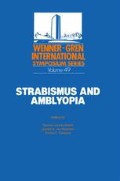Abstract
A complete understanding of infantile strabismus has been hindered by uncertainties regarding the development of oculomotor control in normal infants. Normative oculomotor development cannot be understood without information about the sensory stimuli that drive eye movements and about the adaptive mechanisms that fine-tune the synergy between sensory stimuli and oculomotor commands. In the past decade, much has been learned about the characteristics of eye movements in normal infants (Aslin, 1987b). However, it remains unclear precisely why oculomotor control is initially deficient and what mechanism leads to oculomotor maturity.
Supported by NIH research grant (EY-05976) to R.N.A. and by NIH center grant (EY-01319) to the Center for Visual Science.
Access this chapter
Tax calculation will be finalised at checkout
Purchases are for personal use only
Preview
Unable to display preview. Download preview PDF.
References
Aslin, R. N. (1977). Development of binocular fixation in human infants. J. Exper. Child Psychol., 23, 133–150.
Aslin, R. N. (1981). Development of smooth pursuit in human infants. In Eye Movements: Cognition and Visual Perception (eds. D. F. Fisher, R. A. Monty, and J. W. Senders). Erlbaum, Hillsdale, NJ.
Aslin, R. N. (1985). Oculomotor measures of visual development. In Measurement of Audition and Vision in the First Year of Postnatal Life: A Methodological Overview. (eds. G. Gottlieb and N. Krasnegor). Ablex, Norwood, NJ.
Aslin, R. N. (1987a). Anatomical constraints on oculomotor development: Implications for infant perception. In Infant Perception: The Minnesota Symposium on Child Psychology. (ed. A. Yonas). Erlbaum, Hillsdale, NJ.
Aslin, R. N. (1987b). Motor aspects of visual development in infancy. In Handbook of Infant Perception, Vol. 1. (eds. P. Salapatek and L. B. Cohen). Academic Press, Orlando, FL.
Aslin, R. N. and Jackson, R. W. (1979). Accommodative-convergence in young infants: Development of a synergistic sensory-motor system. Canadian J. Psychol., 33, 222–231.
Aslin, R. N. and Salapatek, P. (1975). Saccadic localization of visual targets by the very young human infants. Percept. Psychophys., 17, 293–302.
Banks, M. S. (1980). The development of visual accommodation during early infancy. Child Develop., 51, 646–666.
Banks, M. S. and Dannemiller, J. L. (1987). Infant visual psychophysics. In Handbook of Infant Perception, Vol. 1. (eds. P. Salapatek and L. B. Cohen). Academic Press, Orlando, FL.
Birch, E. E., Shimojo, S., and Held, R. (1985). Preferential-looking assessment of fusion and stereopsis in infants aged 1–6 months. Invest. Ophthal. Visual Sci., 26, 366–370.
Bronson, G. W. (1983). Potential sources of error when applying a corneal reflex eye-monitoring technique to infant subjects. Behav. Res. Meth. Instrum., 15, 22–28.
Duwaer, A. L. and van den Brink, G. (1981). Diplopia thresholds and the initiation of vergence eye movements. Vision Res., 21, 1727–1737.
Enright, J. T. (1986). Facilitation of vergence changes by saccades: Influences of misfocused images and of disparity stimuli in man. J. Physiol. (London), 371, 69–87.
Held, R., Birch, E., and Gwiazda, J. (1980). Stereoacuity of human infants. Proc. National Acad. SCi. U.S.A., 77, 5572–5574.
Maurer, D. (1975). The development of binocular convergence in infants. (Doctoral dissertation, University of Minnesota, 1974). Dissertation Abstracts, 35, 6136-B.
Miles, F. A. (1985). Adaptive regulation in the vergence and accommodation control systems. In Adaptive Mechanisms in Gaze Control: Facts and Theories. (eds. A. Berthoz and G. Melvill Jones). Elsevier, Amsterdam.
Optican, L. M. and Robinson, D. A. (1980). Cerebellar-dependent adaptive control of primate saccadic system. J. Neurophysiol., 44, 1058–1076.
Optican, L. M., Zee, D. S., and Chu, F. C. (1985). Adaptive response to muscle weakness in human pursuit and saccadic eye movements. J. Neurophysiol., 54, 110–122.
Rashbass, C. and Westheimer, G. (1961). Disjunctive eye movement. J. Physiol. (London), 159, 339–360.
Rethy, I. (1969). Development of the simultaneous fi xation from the divergent anatomic eye-position of the neonate. J. Pediatric Ophthal., 6, 92–96.
Schor, C. M., Wood, I., and Ogawa, J. (1984). Binocular sensory fusion is limited by spatial resolution. Vision Res., 24, 661–666.
Shimojo, S., Bauer, J., O’Connell, K. M., and Held, R. (1986). Prestereoptic binocular vision in infants. Vision Res., 26, 501–510.
Slater, A. M. and Findlay, J. M. (1975). Binocular fixation In the newborn baby. J. Exper. Child Psychol., 20, 248–273.
Snow, R., Hore, J., and Vilis, T. (1985). Adaptation of saccadic and vestibulo-ocular systems after extraocular muscle tenectomy. Invest. Ophthal. Visual. Sci., 26, 924–931.
Tychsen, L. and Lisberger, S. G. (1986). Maldevelopment of visual motion processing in humans who had strabismus with onset in infancy. J. Neurosci., 6, 2495–2508.
Vilis, T., Yates, S., and Hore, J. (1985). Visual patching of one eye produces changes in saccadic properties in the unseeing eye. Dev. Brain Res., 17, 290–292.
Westheimer, G. and Mitchell, D. E. (1969). The sensory stimulus for disjunctive eye movements. Vision Res., 9, 749–755.
Wickelgren, L. (1967). Convergence in the human newborn. J. Exper. Child Psychol., 5, 74–85.
Yuodelis, C. and Hendrickson, A. (1986). A qualitative and quantitative analysis of the human fovea during development. Vision Res., 26, 847–855.
Editor information
Editors and Affiliations
Copyright information
© 1988 The Wenner-Gren Center
About this chapter
Cite this chapter
Aslin, R.N. (1988). Normative Oculomotor Development in Human Infants. In: Lennerstrand, G., von Noorden, G.K., Campos, E.C. (eds) Strabismus and Amblyopia. Wenner-Gren Center International Symposium Series. Palgrave Macmillan, London. https://doi.org/10.1007/978-1-349-10403-1_12
Download citation
DOI: https://doi.org/10.1007/978-1-349-10403-1_12
Publisher Name: Palgrave Macmillan, London
Print ISBN: 978-1-349-10405-5
Online ISBN: 978-1-349-10403-1
eBook Packages: MedicineMedicine (R0)

